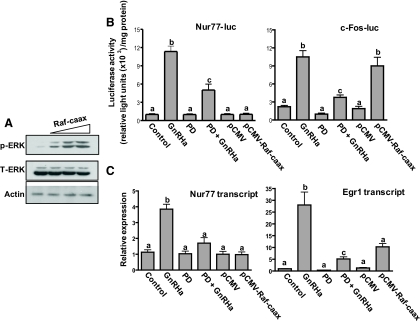Fig. 3.
ERK signaling is required, but not sufficient, for GnRH-induced transcriptional up-regulation of Nur77 in αT3-1 cells. A, αT3-1 cells were transfected for 4 h with increasing quantities (0.25, 1.0, or 2.5 μg) of Raf-CAAX expression vector. After an additional 4 h incubation in complete media, cell lysates were analyzed by immunoblot for levels of activated ERK1/2 (p-ERK). Total ERK (T-ERK) and actin immunoreactivity are shown as lane loading controls. B, αT3-1 cells were transfected with a Nur77-luciferase reporter (Nur77-luc, left panel) or a c-Fos-luciferase reporter (c-Fos-luc, right panel). In addition, some cells were transfected with empty control vector or a Raf-CAAX expression vector to stimulate hormone-independent activation of the ERK pathway. Cells were pretreated or not as indicated with the MEK inhibitor PD90859 (PD; 50 μm), and/or the GnRH agonist buserelin (GnRHa; 10 nm). Bars represent mean ± sem normalized luciferase activity of three replicates within a single experiment. Each experiment was repeated at least three times with similar results. Bars with different letter designations represent mean values that are statistically significantly different at P < 0.05. C, αT3-1 cells were pretreated or not with PD98059 or were transfected with empty vector or Raf-CAAX as indicated and were then treated with either vehicle or GnRHa as in A. Bars represent mean ± sem (n = 3) endogenous Nur77 (left panel) or Egr1 (right panel) transcript levels as measured by qPCR. Bars with different letter designations represent mean values that are statistically significantly different at P < 0.05. These experiments were repeated at least three times with similar results.

